|
|
|
|
World
War 2: |
|
|
German
research to develop secret
weapons |
|
German rocket scientists had two unofficial research projects "on the drawing board" as early as 1930: a "pilotless plane" (or "robot bomb"), and a long range rocket. The Nazis were sufficiently impressed to give their leader Werner von Braun a rocket base and test-firing range at Peenemunde on the Baltic coast. By 1937 both projects were being developed by the Nazi German government. Lack of
urgency Only then did Hitler give top priority to the long range rocket project. Thousands of people were sent to work at Peenemunde - most of them slave labourers. Test-firing the new fourth version rocket began in March 1942, and its fourth launch in Oct.1942 was successful. When Hitler heard the news he gave the immediate go-ahead to mass-produce the rockets, and to build concrete launching bunkers in the Pas-de-Calais. Back to top |
 Test firing a V2 at Peenemunde, safely out of range of British bombers until the later part of the war.  The long distance rocket on a mobile launcher, being lifted to vertical position before firing |
|
Development
of the V1 robot bomb 1942-43 The problem was, getting it to work! In tests it kept crashing. Eventually a brave woman pilot volunteered to fly one (with makeshift controls) to see what was going wrong. She found that the autopilot responded wrongly to cross-winds - by May 1943 the modified V1 was working OK. 1944: launching V1s from
Northern France Almost 9,250 V1's were fired against
London, but less than 2,500 reached their target. In flight
they were almost as vulnerable as their ramps: about 2,000
were destroyed by anti-aircraft gunfire; 2,000 by fighter
planes, and almost 300 by barrage balloons. |
 V1 rocket in flight  V1 rockets being assembled in an underground assembly-line factory 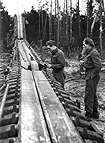 V1 rocket launching ramp - speedily erected, but easily spotted from the air |
|
Feared
long-range V2 rockets |
|
  1. MAP: sites for testing, mass-production and launching of the secret weapons 2. The DORA camp at Nordhausen where deportees from all over Eirope assembled the complex V2 mechanisms. |
|
|
V2 launching bases -
never used |
|
 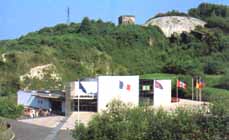 1. Eperlecques - the first concrete bunker which was built for assembling V2s, part destroyed by bombing with "Tallboys". The nazis switched it tomanufacturing liquid oxygen fuel for rockets at la Coupole nearby. 2. The second V2 rocket base is now La Coupole Museum - the concrete dome in the hillside shelters a bomb-proof bunker where the rockets would have been assembled and prepared for launching. Back to top |
|
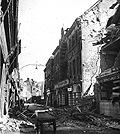 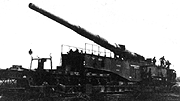 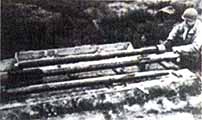 1. Conventional long range guns shelled Dover (Snargate St, left) from the coast of Nord PasdeCalais. 2. Cross-channel gun - Dover was constantly shelled across the 20 mile Straits. 3. V3 rockets: towards the end of the war, these longer-range projectiles could be fired from a super-long gun barrel on the French coast to reach London. |
|
|
V3, the third vengeance weapon, consisted of barrages of small rocket projectiles fired from an underground cannon and capable of reaching London from the north French coast at a speed of 1500 metres a second. Waves of 300 rockets an hour could have been fired, but the V3 was also abandoned unfinished as Allied troops captured it after D-Day. Both the V2 and V3 bases were subjected to heavy bombing raids with the "Tallboy" - a bomb specially developed to pierce the thick concrete of the V-weapon bases. (picture below R) Back to top |
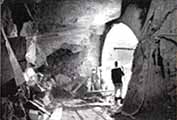 Work on building the V3 cannon at Mimoyecques |
|
Places to
visit: |
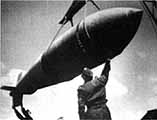 "Tallboy" concrete piercing bombs - developed to shatter the thick "bomb-proof" concrete of the V-weapon bases |
|
|
Related background
information |
|
|
|
|
|
